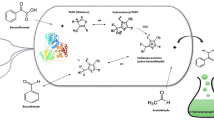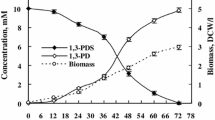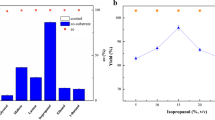Abstract
Bioreduction of 1-phenyl-2-propanone to prepare (S)-1-phenyl-2-propanol, a useful pharmaceutical intermediate, was performed with growing cells of Rhodococcus erythropolis JX-021, giving 14 mM (1.9 g/L) product in 99% e.e. at 5 h in the catalysis of 15 mM substrate. The reduction stopped afterwards due to strong inhibition of substrate and formed product, a problem that is often encountered in biotransformation. While the substrate inhibition was solved by stepwise feeding, product inhibition was tackled by different methods: repeated removal of the product by centrifugation, by absorption with Amberlite XAD-7 resin, and by the use of dodecanol as the second phase gave the final product in 58, 68, and 61 mM in the catalysis of 80 mM substrate, respectively. The inhibition was caused by the partial permeabilization of cell membrane of R. erythropolis JX-021, and addition of NADPH or glucose 6-phosphate to such cell culture retained the reduction activity. Therefore, higher productivity in the reduction of 1 with resting cells of R. erythropolis JX-021 was achieved through cofactor regeneration and recycling by the addition of glucose and permeabilized cells of Bacillus subtilis BGSC 1A1 containing a glucose dehydrogenase, giving the product in 62 mM without addition of cofactor and 78 mM with the addition of 0.01 mM NADP+ in the catalysis of 120 mM substrate. The product e.e. retained 99% during the process which showed industrial possibility.




Similar content being viewed by others
References
Nakamura, K., & Matsuda, T. (2002). In K. Drauz & H. Waldmann (Eds.), Enzyme catalysis in organic synthesis (Vol. III, pp. 991–1047). Hoboken: Wiley-VCH. Chap 15.
Faber, K. (1997). Biotransformations in organic chemistry, chap. 2.2 (pp. 160–200). Berlin: Springer.
Pereira, R. S. (1998). Critical Reviews in Biotechnology, 18, 25–64.
Kroutil, W., Mang, H., Edegger, K., & Faber, K. (2004). Current Opinion in Chemical Biology, 8, 120–126.
Stampfer, W., Kosjek, B., Moitzi, C., Kroutil, W., & Faber, K. (2002). Angewandte Chemie International Edition, 41, 1014–1017.
Yoshihiko, Y., Noriyuki, K., Junzo, H., Masaru, W., Michihiko, K., & And Shimizu, S. (2000). Bioscience, Biotechnology, and Biochemistry, 64, 1430–1436.
Rodriguez, S., Schroeder, K. T., Kayser, M. M., & Stewart, J. D. (2000). The Journal of Organic Chemistry, 65, 2586–2587.
Zhang, J., Duetz, W. A., Witholt, B., & Li, Z. (2004). Chemical Communications, 2120–2121.
Chenault, H. K., & Whitesides, G. M. (1987). Applied Biochemistry and Biotechnology, 14, 147–197.
Donk, W. A., & Zhao, H. M. (2003). Current Opinion in Biotechnology, 14, 421–426.
Wong, C. H., & Whitesides, G. M. (1981). Journal of the American Chemical Society, 103, 4890–4899.
Yang, W., Xu, J. H., Pan, J., Xu, Y., & Wang, Z. L. (2008). Biochemical Engineering Journal, 42, 1–5.
Kizaki, N., Yasohara, Y., Hasegawa, J., Wada, M., Kataoka, M., & Shimizu, S. (2001). Applied Microbiology and Biotechnology, 55, 590–595.
Kataoka, M., Yamamoto, K., Kawabata, H., Wada, M., Kita, K., Yanase, H., et al. (1999). Applied Microbiology and Biotechnology, 51, 486–490.
Zhang, J., & Witholt, B., Li, Z. (2006). Chemical Communications, 398–400.
Zhang, J., Witholt, B., & Li, Z. (2006). Advanced Synthesis & Catalysis, 348, 429–433.
Gbewonyo, K., Buckland, B. C., & Lilly, M. D. (1991). Biotechnology and Bioengineering, 37, 1101–1107.
Roddick, F. A., & Britz, M. L. (1997). Journal of Chemical Technology and Biotechnology, 69, 383–391.
Martin, H., Suske, W., Schmid, A., Engesser, K.-H., Kohler, H.-P., Witholt, B., et al. (1998). Journal of Molecular Catalysis B, Enzymatic, 5, 87–93.
Schmid, A., Sonnleitner, B., & Witholt, B. (1998). Biotechnology and Bioengineering, 60, 10–23.
Buhler, B., Bollhalder, I., Hauer, B., Witholt, B., & Schmid, A. (2003). Biotechnology and Bioengineering, 81, 683–694.
Filho, M. V., Stillger, T., Muller, M., Liese, A., & Wandrey, C. (2003). Angewandte Chemie International Edition, 42, 2993–2996.
Bracher, F., & Litz, T. (1994). Archives de Pharmacie, 327, 591–593.
Erdelyi, B., Szabo, A., Seres, G., Birincsik, L., Ivanics, J., Szatzker, G., et al. (2006). Tetrahedron: Asymmetry, 17, 268–274.
Kruse, W., Kragl, U., Wandrey, C. (1996) DE 4436149 A1.
Acknowledgement
This work was supported by the Zhejiang Provincial Natural Science Foundation (grant no. y4080311)
Author information
Authors and Affiliations
Corresponding author
Rights and permissions
About this article
Cite this article
Jin, JZ., Li, H. & Zhang, J. Improved Synthesis of (S)-1-Phenyl-2-Propanol in High Concentration with Coupled Whole Cells of Rhodococcus erythropolis and Bacillus subtilis on Preparative Scale. Appl Biochem Biotechnol 162, 2075–2086 (2010). https://doi.org/10.1007/s12010-010-8983-3
Received:
Accepted:
Published:
Issue Date:
DOI: https://doi.org/10.1007/s12010-010-8983-3




